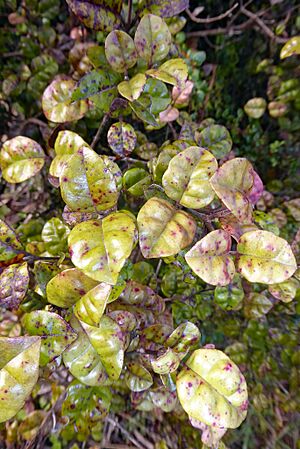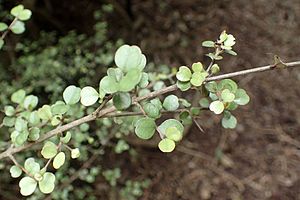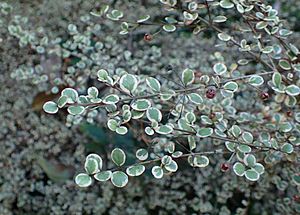Lophomyrtus facts for kids
Quick facts for kids Lophomyrtus |
|
|---|---|
 |
|
| Scientific classification |
|
| Kingdom: | Plantae |
| Clade: | Tracheophytes |
| Clade: | Angiosperms |
| Clade: | Eudicots |
| Clade: | Rosids |
| Order: | Myrtales |
| Family: | Myrtaceae |
| Subfamily: | Myrtoideae |
| Tribe: | Myrteae |
| Genus: | Lophomyrtus Burret |
| Type species | |
| Lophomyrtus bullata |
|
Lophomyrtus is a group of plants in the myrtle family. Scientists first described this group in 1941. All Lophomyrtus plants grow only in New Zealand. This means they are endemic there. These plants are evergreen shrubs or trees. This means they keep their leaves all year round. They are famous for their colorful leaves. These leaves can be purple, chocolate, red, or bronze-green. There are also many special types called cultivars. These are plants grown for certain features.
To get the best leaf color, plant Lophomyrtus in full sunlight. If the weather is cool, the plant might need a protected spot. They can also grow well in partial shade. Lophomyrtus plants are related to the Australian Lenwebbia. Both have four petals and similar leaves. However, Lenwebbia leaves are not as colorful.
Contents
Different Kinds of Lophomyrtus
There are two main species of Lophomyrtus. They are both native to New Zealand.
Ramarama (Lophomyrtus bullata)
The Ramarama is an evergreen shrub or small tree. It can grow up to 5 meters (about 16 feet) tall. It has shiny leaves that look bumpy or puckered. In summer, it grows small, creamy white flowers. After the flowers, it produces small, soft fruits. These fruits turn a black-red color when they are ripe. A special type of Ramarama is 'Maitai Bay'. It has very bright red-brown leaves. Ramarama plants are found on the North Island of New Zealand. They also grow in the northern part of the South Island.
Rōhutu (Lophomyrtus obcordata)
The Rōhutu can grow to about 8 meters (about 26 feet) tall. It often grows more like a tree. Its leaves are very small and shaped like an upside-down heart. In summer, it has tiny white flowers that grow in groups. These flowers turn into small, dark red or purple-red berries. Some special types of Rōhutu are 'Dainty' and 'Microphylla'. They have leaves with a pink tint. Rōhutu plants grow all over New Zealand. However, they are not found in much of the Southland region.
Lophomyrtus Hybrids: New Varieties
Many Lophomyrtus plants you see in gardens are actually hybrids. A hybrid is a mix of two different species. Most garden Lophomyrtus are a cross between Lophomyrtus bullata and Lophomyrtus obcordata. This special hybrid is called Lophomyrtus × ralphii.
Lophomyrtus × ralphii has led to many popular garden plants. These plants come in different sizes and leaf colors. Here are some well-known types:
- Kathryn: This plant can grow up to 3 meters (about 10 feet) tall. It has deep purple-bronze leaves.
- Indian Chief: Its leaves are red-brown. They get even darker in winter.
- Pixie: This is a small, compact plant. It has tiny, bright, red-brown leaves.
- Little Star: This plant is also compact. It has small, round, green leaves with cream edges. These leaves often have a pink color.
- Gloriosa: This plant grows upright, up to 2 meters (about 6.5 feet) tall. Its green leaves have cream edges and turn pink, especially in winter.
- Black Beauty: This plant grows tall and narrow, up to 2 meters (about 6.5 feet) tall. It has very dark red-brown leaves.
- Red Dragon: This plant grows up to 1.8 meters (about 6 feet) tall. It has narrow red leaves that become a dark chocolate color as they get older.
Gardeners like Lophomyrtus × ralphii plants for their beautiful leaves. They can also be trimmed and shaped easily. While their flowers and fruits are pretty, people mostly grow these plants for their colorful foliage.
See also
 In Spanish: Lophomyrtus para niños
In Spanish: Lophomyrtus para niños




